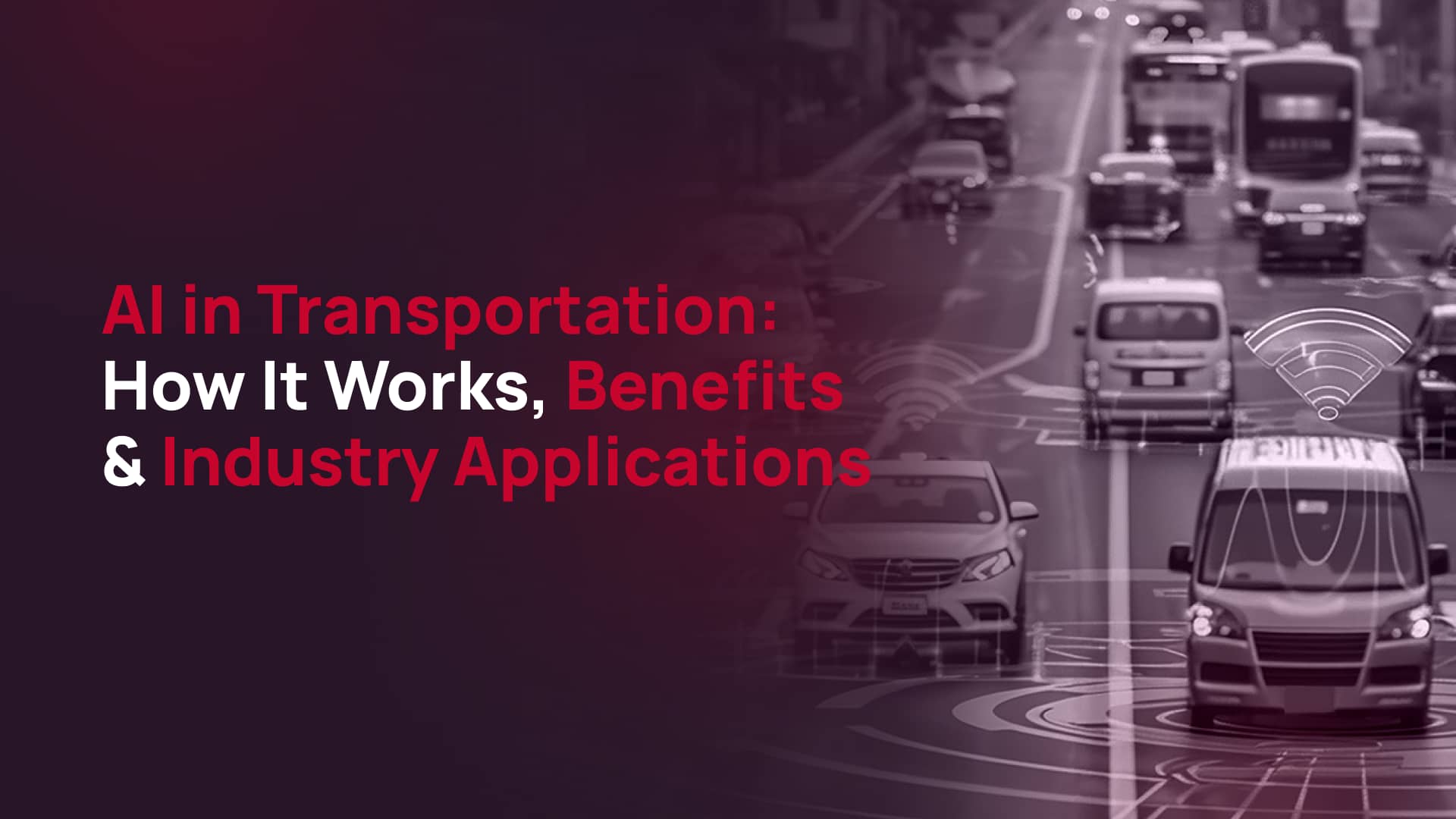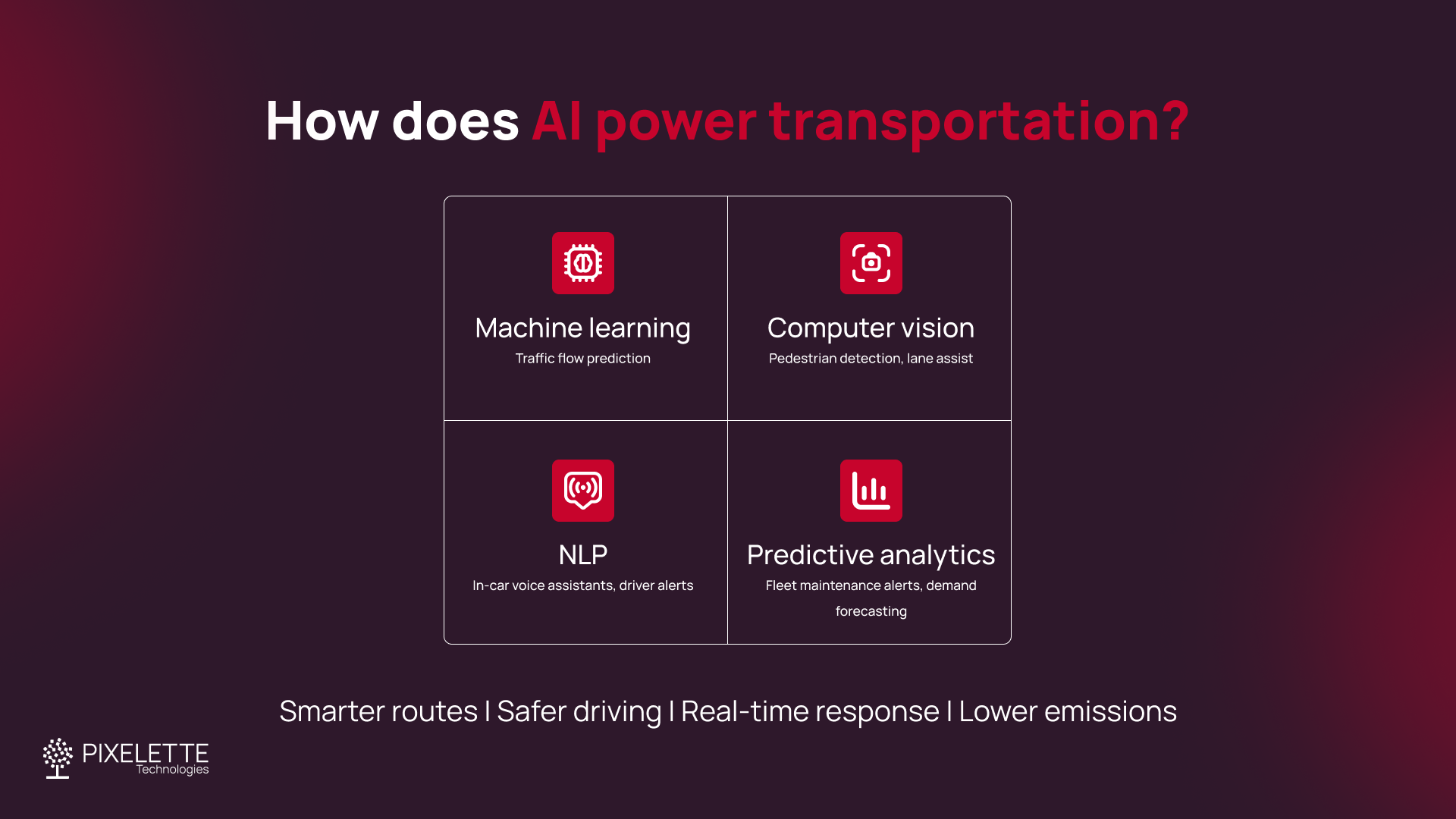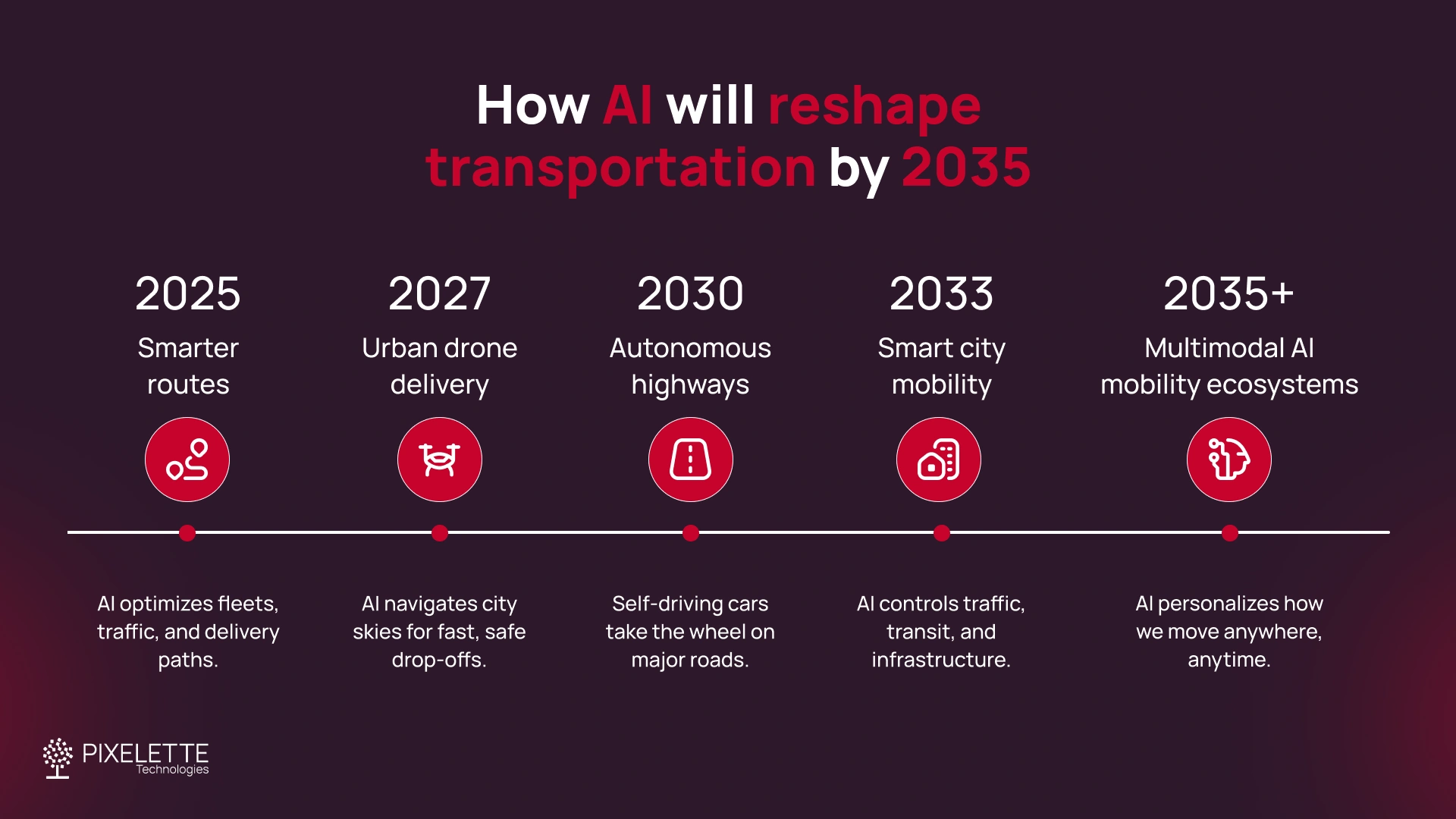AI in Transportation: How It Works, Benefits & Industry Applications
Written by
Sara Illahi Panhwar
Last Updated: July 2, 2025

The Future of AI Starts Here
Opt for our AI development services to create intelligent, scalable and efficient solutions. Let’s push the boundaries together. Get Started with a Free Consultation Now.
Today, artificial intelligence (AI) in transportation is being used widely with multiple applications. We have driverless cars that can operate on their own, we can find the fastest route to get to our destination, and get instant traffic updates.
This is exciting because what once relied on guesswork is now handled by algorithms that learn and adapt in real-time. According to recent statistics reported by Dialectica, the global transportation market is expected to reach $11.1 trillion by 2030, growing at a CAGR of 5.4%. The industry is undergoing new changes, and new ideas keep pouring in.
As the urban centers get more and more crowded, traditional transportation methods are facing significant strain. The demand for mobility is at an all-time high. With AI churning out real-time data analysis, offering automation and predictive capabilities, people have realized that it matters today more than it ever did.
In this article, we will be talking about how AI is used in transportation, the benefits of using AI in transportation, and look at some of its real-world applications and emerging trends shaping the future of transportation. There's a lot for you to discover, so let's begin by understanding how this works.
How AI works in transportation
Some of the most interesting examples of transportation technology we see today, such as Tesla’s self-driving car and Google Maps for navigation, are all powered by AI. So, the question arises, how is AI used in transportation? Multiple technologies work together behind the scenes to make this possible.
Let’s break down the key technologies involved to understand how AI is transforming transport systems.

1. Machine learning (ML)
It is perhaps among the most important technologies in the AI tech stack because it is responsible for enabling systems to learn from a vast amount of transportation data. This data includes traffic flow, road conditions, vehicle speed, driver behavior, etc. ML uses this data to identify key patterns and make decisions based on it.
2. Computer vision
It uses cameras and sensors to interpret signals from the environment. This allows the system to identify objects (pedestrians, buildings, cars), respond to lane markings, and evaluate road conditions. Autonomous vehicles can not exist without computer vision.
3. Natural language processing (NLP)
Natural language processing techniques are specifically used in voice-enabled GPS systems, and its core aim is to make interactions easy and accessible with various AI-backed transportation platforms.
4. Predictive analytics
As the name suggests, this AI technology uses historical and real-time data to predict and forecast parameters such as future traffic trends, potential delays, maintenance needs, etc.
Key benefits of AI in transportation
Now that you are aware of the examples of transportation technology, here are some key benefits of implementing AI in transportation:
a. Improved safety
Safety remains one of the top priorities, and AI in transportation brings this to us through Advanced Driver-Assistance Systems (ADAS) that use real-time data, sensors, and computer vision to detect obstacles, monitor driver behavior, and prevent accidents. Lane-keeping assistance, automated braking, and collision alerts are just a few of the ADAS features that can lower the number of collisions that occur while a car is on the road.
b. Enhanced efficiency
AI helps you plan routes, coordinate with the fleet, and manage traffic by analyzing data. This improves the overall efficiency and allows you to save as much of your time, energy, and costs as possible. For instance, if a particular route is jammed, it will show you an alternative shortest route possible to reach your destination so that you don’t end up getting stuck in traffic and wasting your fuel.
c. Reduced operational costs
AI-powered transportation has the potential to help companies save up to 10% to 20% when it comes to maintenance costs. AI leverages predictive maintenance, which helps identify problems and issues within the vehicle before they lead to any breakdowns.
d. Increased sustainability
The transportation industry runs on fuel. The usage of fuel is not a problem; the lack of its optimization is. Fuel consumption leads to harmful emissions that are not good for environmental sustainability. AI helps reduce unnecessary idling and fuel waste, thereby enabling the world to achieve global environmental goals without compromising trade and business.
Industry applications & examples of transportation technology
AI in transportation is picking up pace, making mobility faster and more efficient. Let’s look at some of the key areas where AI is making a real impact, along with some interesting examples of transportation technology in action.
1. Urban mobility
A number of cities around the world are prioritizing efficiency in urban mobility and are incorporating AI to achieve this goal. One great example is smart traffic lights that use real-time traffic data to adjust signal timing.
This prevents congested roads by keeping the traffic running smoothly. While this is a very small example, there are ride-hailing apps such as Lyft and Uber that are using AI algorithms to match riders with nearby drivers, optimize pick-and-drop points, and adjust pricing based on peak demand hours.
2. Autonomous vehicles
AVs are definitely the highlight of the last decade. AVs also make the most important AI use case. Self-driving cars, trucks, and shuttles use a combination of sensors, ML, and computer vision to interpret the world around them and take control of the vehicle. Companies like Tesla and Cruise are the top providers of AVs and they are harnessing AI’s potential to do what was unthinkable a few decades ago.
3. Logistics and supply chain management
AI has been consistently helping transportation companies accurately forecast and optimize operations to meet demand more effectively. Route optimization as a feature is especially useful because it can analyze traffic, weather conditions, and delivery schedules to find paths that are best suited for a vehicle.
This helps them avoid getting stuck in traffic, conserve fuel, and deliver goods on time. Industry giants like Amazon and FedEx are already using AI to automate their operations and improve customer satisfaction.
4. Improve public transportation
The existing public transportation structure is changing with AI. Today, AI can provide you with real-time tracking, passenger flow analysis, and predictive maintenance. These are some of the factors that help transit authorities improve scheduling and enhance the overall rider experience.
5. Freight and cargo tracking with AI-powered sensors
AI is really helping with tracking big shipments and cargo. AI-powered sensors provide real-time updates that allow you to trace where your shipment is, detect temperature changes, potential tampering, or delays. It gives companies more control over their supply chains and improves transparency.
How AI will change the future of transportation
As artificial intelligence continues to advance, it’s opening up previously unimaginable possibilities, especially in the transportation industry. One highly anticipated change is the rise of fully autonomous and driverless vehicles. Some vehicles have already gone semi-autonomous, and we are striving to go completely autonomous. This shift can reduce the number of accidents, free up time for people spent behind the wheel, and improve overall road safety.

Apart from the vehicles, AI is fueling the development of smart cities. As the cities become densely populated, integrating AI into urban infrastructure can solve daily challenges like traffic congestion and overloaded public transport. For example, AI-enabled parking systems use sensors and predictive analytics to guide drivers to available spots, so they don’t waste time driving in circles. Similarly, public transport vehicles, such as buses are dispatched based on when and where people need them the most.
Another area is AI-powered drone delivery. These drones will deliver packages and orders faster and with lower emissions than traditional vehicles because they can easily bypass ground traffic. This also enhances accessibility to remote areas, and with the help of these AI-powered drones, we can also deliver aid to disaster-affected areas.
Of course, there will be challenges along the way. Government regulations make it difficult to implement such changes, and since AI systems rely heavily on personal and location data to function effectively, data privacy becomes another major concern to note. Lastly, adoption is another issue because incorporating new technology into infrastructure that has been in place for decades is very difficult, particularly when you’re doing so on a large scale. Still, the long-term outlook is promising. AI will make the transportation ecosystem environmentally sustainable, promote safety, accessibility, and overall mobility.
Conclusion
In conclusion, AI in transportation has immense transformative potential. The possibilities in this industry are expanding rapidly, and progressive businesses are already reaping its benefits. However, effective AI adoption calls for the right approach and expertise.
If you’re looking to incorporate AI into your transportation business, consider an expert AI development service company like Pixelette Technologies to tap into the full potential of AI and bring your idea to life.




